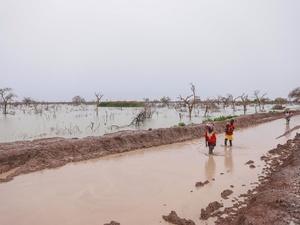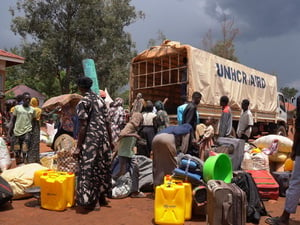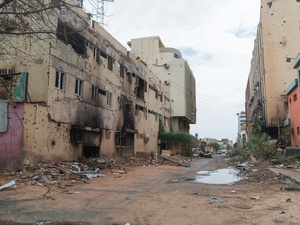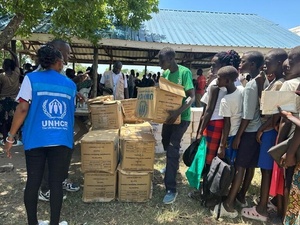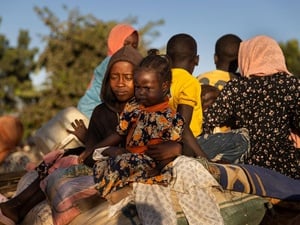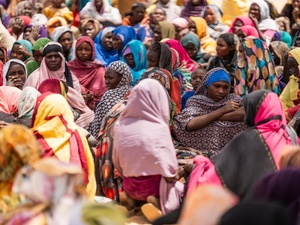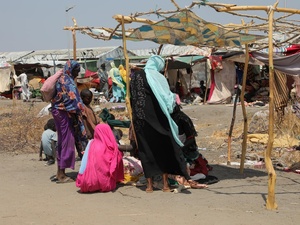On eve of South Sudan 5th Anniversary, forced displacement continues to rise
On eve of South Sudan 5th Anniversary, forced displacement continues to rise
As South Sudan marks its fifth anniversary of independence on 9 July, UNHCR remains gravely concerned by the continuing violence in parts of the country and the resulting forced displacement of South Sudanese people, both internally and throughout the neighboring region.
The world’s youngest nation currently ranks among the countries with the highest levels of conflict-induced population displacement globally. Nearly one in four of the South Sudan’s citizens is displaced within its borders or in neighboring countries, affecting some 2.6 million people against a population that stood at 11.3 million in 2013. A large majority are children.
Civilians in South Sudan continue to bear the brunt of armed conflict. Sporadic clashes are commonplace, while growing food insecurity and deteriorating economic conditions foretell a grim outlook for the country at large. Agencies report that the number of food insecure people in the country is expected to increase from 4.3 million to 4.8 million in line with seasonal vulnerabilities and the economic crisis.
Despite the peace agreement that formally ended the civil war in August 2015, conflict and instability has spread to previously unaffected areas in the Greater Equatoria and Greater Bahr-El-Ghazal regions. Last month, deadly clashes in Wau resulted in the deaths of more than 40 people while up to 35,000 fled their homes. Such fighting is characteristic of the trend that produced fresh refugee outflows this year.
In the nine months that the ceasefire has been observed, there has been no major return movement from countries of asylum. In that period, the number of internally displaced people rose by 100,000, while UNHCR registered nearly 140,000 new refugees. There are now over 860,000 South Sudanese refugees in neighboring countries, making it the world’s fourth largest refugee producing country, and second largest in sub-Saharan Africa after Somalia.
Notwithstanding these challenges, South Sudan is host to more than 272,000 refugees from mainly Sudan (251,000), with smaller numbers from the Democratic Republic of Congo (14,799), Ethiopia (4,400) and the Central African Republic (1,878). This year the country has experienced the arrival of some 9,000 new refugees as a result of conflict in the Southern Kordofan and Blue Nile states of Sudan.
Neighboring countries continue to maintain open borders for South Sudanese refugees, and there is ongoing engagement with host communities. Since 2015, 22,000 individuals have fled fighting in Western Equatoria into remote parts of the Central African Republic and the Democratic Republic of Congo. In both countries, insecurity and logistical difficulties are affecting humanitarian access. Meanwhile, Sudan has received the highest number of new South Sudanese refugees this year. With 231,581 individuals, it is now the second highest refugee hosting country after Ethiopia (285,356). They are followed by Uganda (229,006) and Kenya (103,173).
Overall, the humanitarian response is sorely lacking due to severe underfunding. UNHCR and 42 non-governmental partners are requesting USD 573 million for refugee protection and assistance programmes. With the inter-agency appeal funded at 17% (USD 85.4 million), agencies are constrained to prioritize emergency response and life-saving assistance activities. As a result, water, sanitation, hygiene, health and shelter interventions in most of the countries of asylum are below the global standard, with the risk of outbreak of diseases. Access to alternative and sustainable household energy is a challenge and one of the main causes of conflict with host communities because refugees are forced to cut firewood for domestic use, a resource that is extremely scarce in some locations.
Children, who constitute 70% of the refugee population, bear the brunt of inadequate resources. More than 16% of them have special needs, including being unaccompanied or separated from family. Children are the worst affected by unpredictable population movements and the upheaval of constant displacements. In Kakuma, Kenya, for example, UNHCR has noted a significant increase in the prevalence of global acute malnutrition among new arrivals in recent months. Lack of funding is hampering case management efforts, including the reunification of unaccompanied and separated children with their families. The average regional ratio of case workers to children with specific needs is 1 case worker per 90 children (the global standard is 1:25). Ethiopia has just 20% of the child protection staff they need.
Gaps remain in meeting minimum education standards with lack of qualified teachers, insufficient classrooms and scholastic materials. Secondary/tertiary education, vocational training and empowerment programmes for adolescents and youth need to be strengthened as a way to reduce the risk of child recruitment. Finally, the majority of host countries are affected by WFP food ration cuts, compounded by the discontinuation of milling vouchers and the challenge of incomplete food baskets. Livelihoods activities were limited in scope and number, and they do not match up to the significant needs of enhancing refugees’ self-reliance.
To download a selection of images from South Sudan, please visit Refugees Media (registration required).
For more information on this topic, please contact:
- In Juba, Rocco Nuri, [email protected], +211 927 725 535
- In Nairobi, Teresa Ongaro, [email protected], +254 735 337 608
- In Nairobi, Duke Mwancha, [email protected], +254 722 207 863
- In Kampala, Charles Yaxley, [email protected], +256 (0) 776 720 045
- In Kinshasa, Andreas Kirchhof, +243 81 700 9484, [email protected]
- In Gambella, Sulaiman Momodou, [email protected], +251 935 978 519
- In Khartoum, Steven O’Brien, [email protected], +249 91 217 9443
- In Geneva, Nora Sturm, [email protected], +41 79 200 7610


